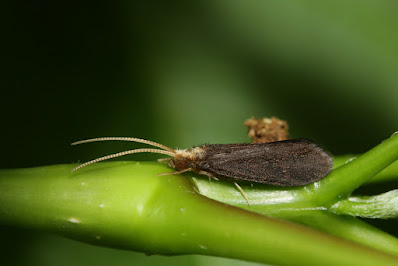The industry-friendly notion that the by-products of GM crops would somehow remain harmlessly in the fields was proved wrong in 2007 when a team of American biologists went out and did some science.
For starters, their investigations confirmed that streams originating adjacent to fields are indeed recipients of both pollen and crop debris deposited by wind and water. Once there, the by-products may be carried away downstream or be decomposed by microbes, but some will be consumed by aquatic invertebrates.
Several species of caddisfly larvae are common in streams. These insects are closely related to moths, the pest targeted by the Bt-toxin in GM maize. They feed in a variety of ways, such as filtering debris out of the water, scraping biofilms off submerged surfaces or chewing on decomposing leaf litter, all of which could potentially expose them to GM maize by-products.
In subsequent experiments, one leaf-shredding species of caddisfly fed Bt corn litter had reduced growth. This could have negative influences on reproductive fitness due, for example, to debility or to life-stages moving out of step with the ecosystem it depends on. Another, surface scraping, species had increased mortality when fed high levels of Bt corn pollen. Because caddisflies play an important role in plant matter decomposition and are a food for predators, harming them will have "ecosystem-scale consequences" in and around agricultural streams.
On the face of it, this was a short, small-scale study of only two species in a limited, highly specialised and localised ecosystem already heavily influenced by adjacent agricultural activity. It should have faded into the background. No doubt it would have, had not the biotech industry pressed the panic-button and thrown its damage-limitation machine into action with a huge, orchestrated attack on the study's authors and their science. Lead author, Rosi-Marshall, said it "went straight through your jugular ..." [1].
The inappropriate and ferocious reaction was because the findings burst several assumption bubbles GM proponents had been happy to keep floating. For example, in the real-world: the natural environment indeed becomes contaminated with GM matter; and the concept that 'harm' to an off-target insect needn't mean 'death' but could refer to any impairment of the organism's role in its ecosystem; and negative effects on one single species could have knock-on ecosystem-wide consequences. A more subtle point, perhaps not lost on the biotech industry is that, if the Bt toxin is truly specific in its action as claimed, the harm to non-target insects caused by the Bt plant matter must have been due to something else, such as unexpected variations in the Bt toxin generated by the GM crop in the field, or side-effects of the gene transformation procedure. Either of these would put the safety of all Bt crops in doubt.
Given the scale of GM crop planting and the increasing number of artificial genes (or edits) in pipeline GM crops, the findings reported were highly problematic for industry claims of Bt's specificity, environmental friendliness, and safety for the consumer.
Since then, a handful of further studies have been published. Most of these also demonstrated harmful, but non-lethal, effects, and a repetition of the 2007 study confirmed significantly lower growth in the same caddisfly species fed the same Bt maize leaves.
A study, published in 2020, tested two further caddisfly species.
It refined the experimental materials to distinguish between effects due to the Bt toxin and the nutritional effects of Bt maize. Maize is not an optimum food for caddisflies and the Bt version
may be further compromised by qualities deriving from the genetic transformation process. To this end, the larvae were fed black alder leaves spiked with Bt toxin at different dose levels. Note that, because it's been observed in the past that well-fed pests are more resistant to Bt, this experiment was designed to minimise the chance of detecting harm [2].
One test species didn't survive well under laboratory conditions, and the experiment was terminated at six weeks. Tellingly, even with a good alder-leaf diet, survival was particularly poor at higher doses of Bt.
The other species was fed the Bt spiked diet for twelve weeks (eight weeks longer than the 2007 study). Their development was slow and their fat stores were low. In the wild, these insects could find themselves out of step with the food web around the watercourse, and could have insufficient reserves to deal with stresses. The results were dose-dependent, a key marker for a toxin.
While Bt protein degrades steadily in the environment, GM monocultures provide a long steady supply of fresh toxic matter. The latest GM maize offering, 'SmartStax', contains six Bt toxins, all of which might produce their own harmful effect on non-target insects possibly made worse by synergistic action, and presenting at a much higher concentration in the leaves than the single-Bt maize tested.
OUR COMMENT
The myth that Bt kills only the target pest and is 'safe' for the environment clearly rests squarely on a don't-look-don't-see attitude: an inadequate definition of 'harm', an inadequate exposure time to the Bt, an inadequate range of test species, and an inadequate monitoring of environmental contamination.
As the Westminster government paves the way for GM crops in UK fields, the amount of Bt (and other GM pesticides) inflicted on our environment and ourselves can only go up. Bring all this assumption-filled non-science to your regulators' attention.
Background
[1] SHOOTING SCIENTISTS (Doc - GMFS Archive) October 2009
[2] EATING WELL KEEPS PESTS WELL - October 2017
Sources:
- E. J. Rosi-Marshall, et al., 2007, Toxins in transgenic crop by-products may affect headwater stream ecosystems, PNAS
- Antonia Pott, et al., 2020, Effect of Bt toxin Cry1Ab on two freshwater caddisfly shredders - an attempt to establish dose-effect relationships through food-spiking, Nature Scientific Reports
- GM Bt toxins harm caddisflies, GM Watch, 6.04.20
Image: caddisfly - from Creative Commons

No comments:
Post a Comment
Thanks for your comment. All comments are moderated before they are published.